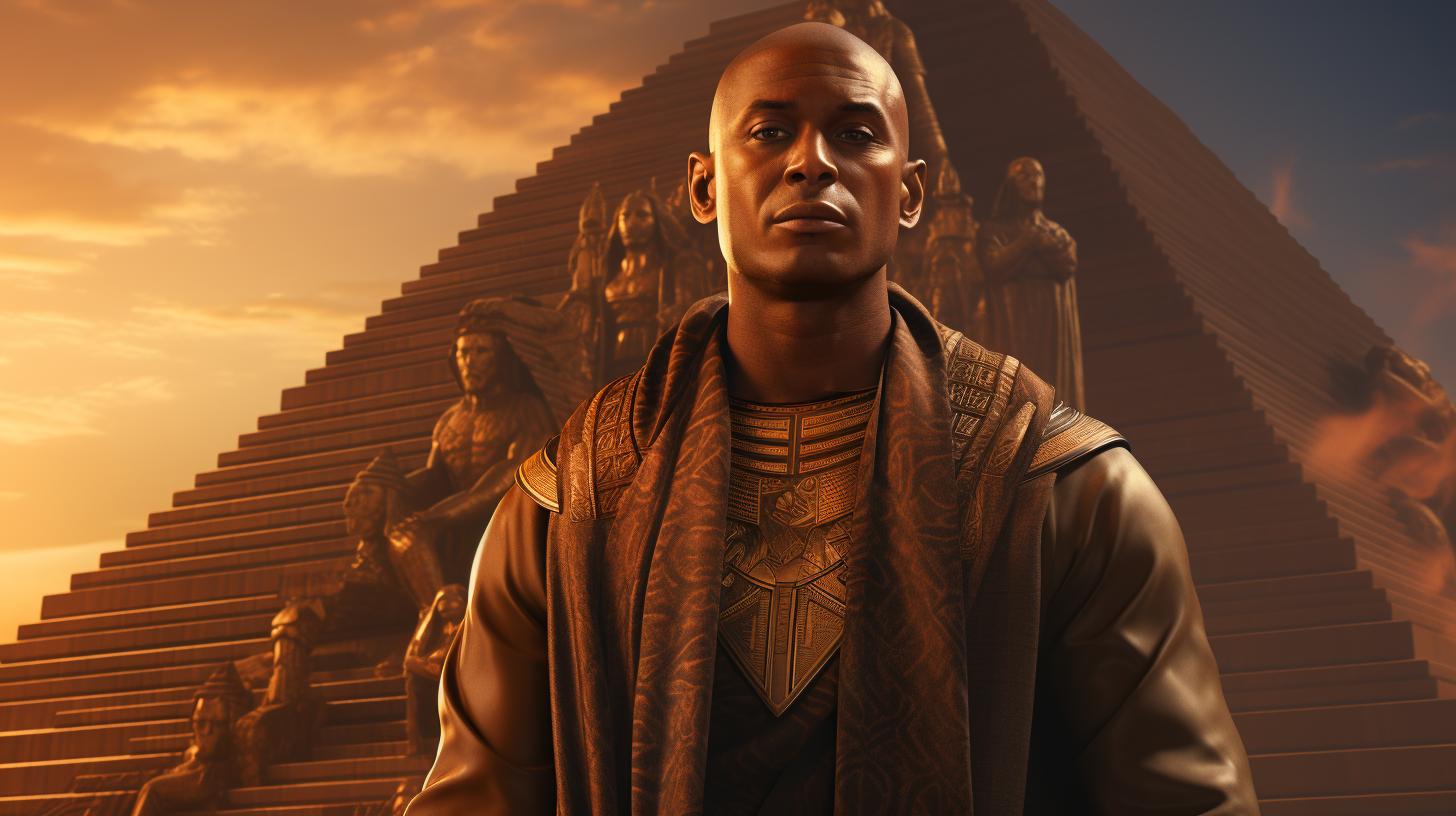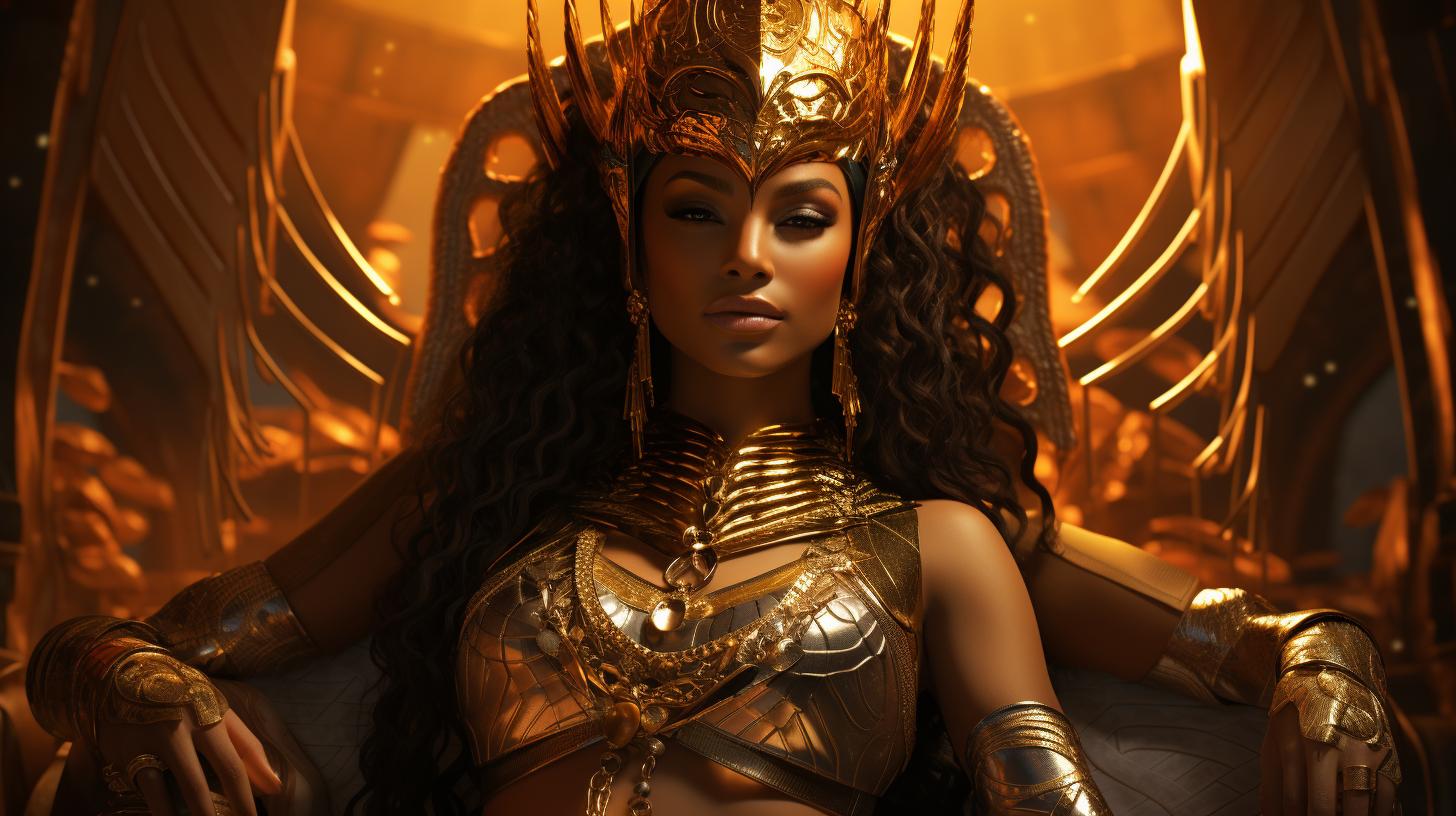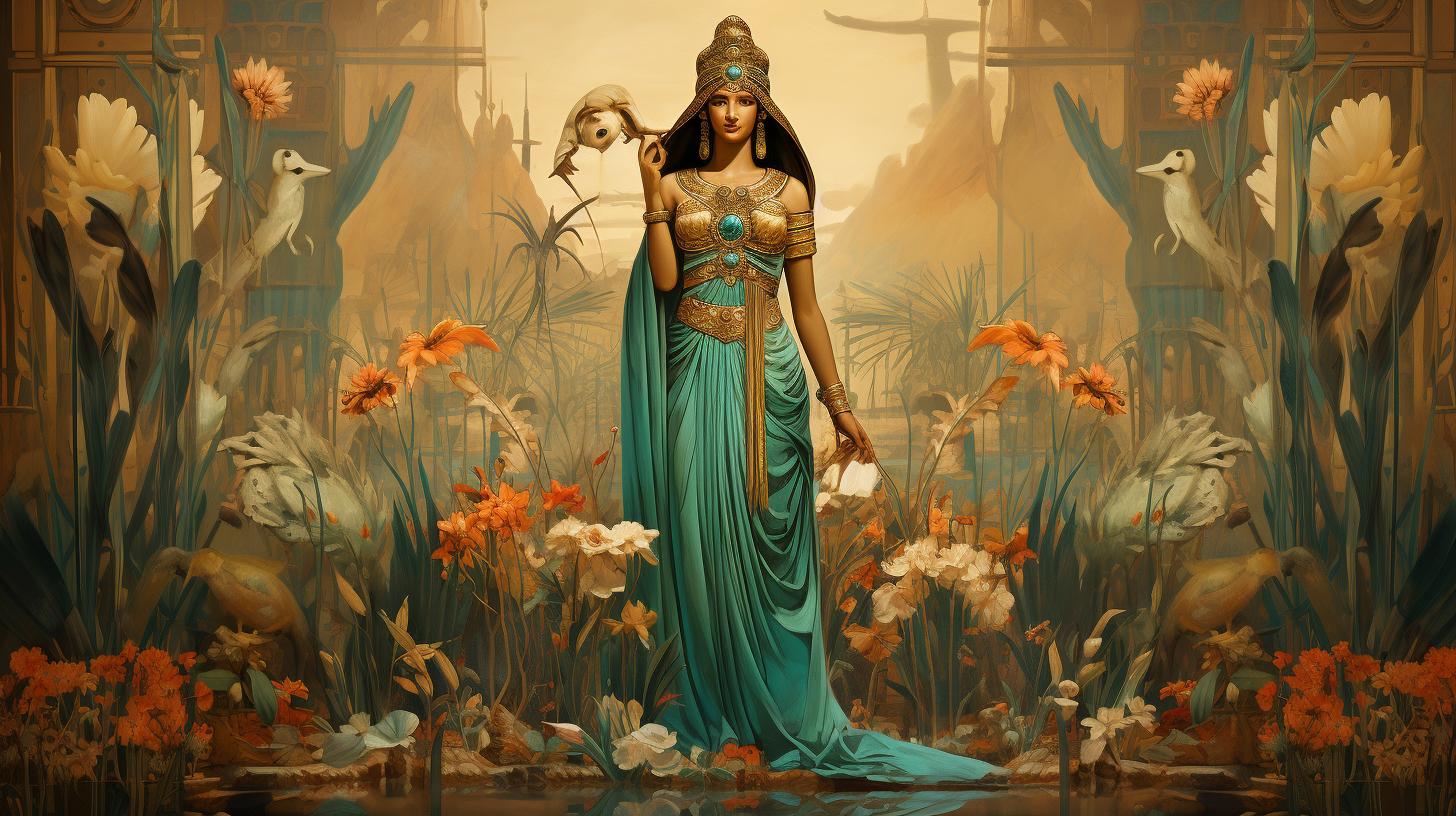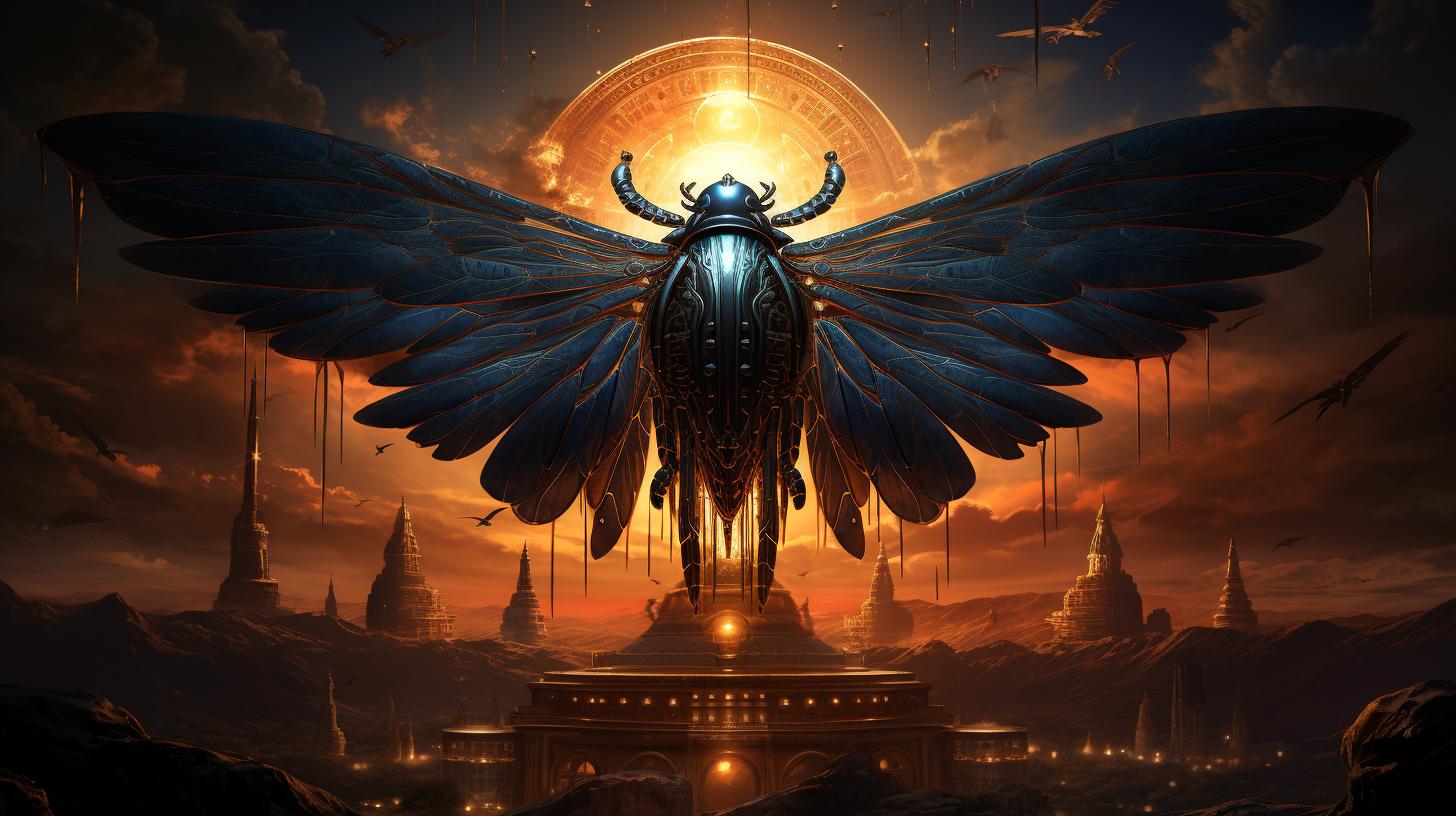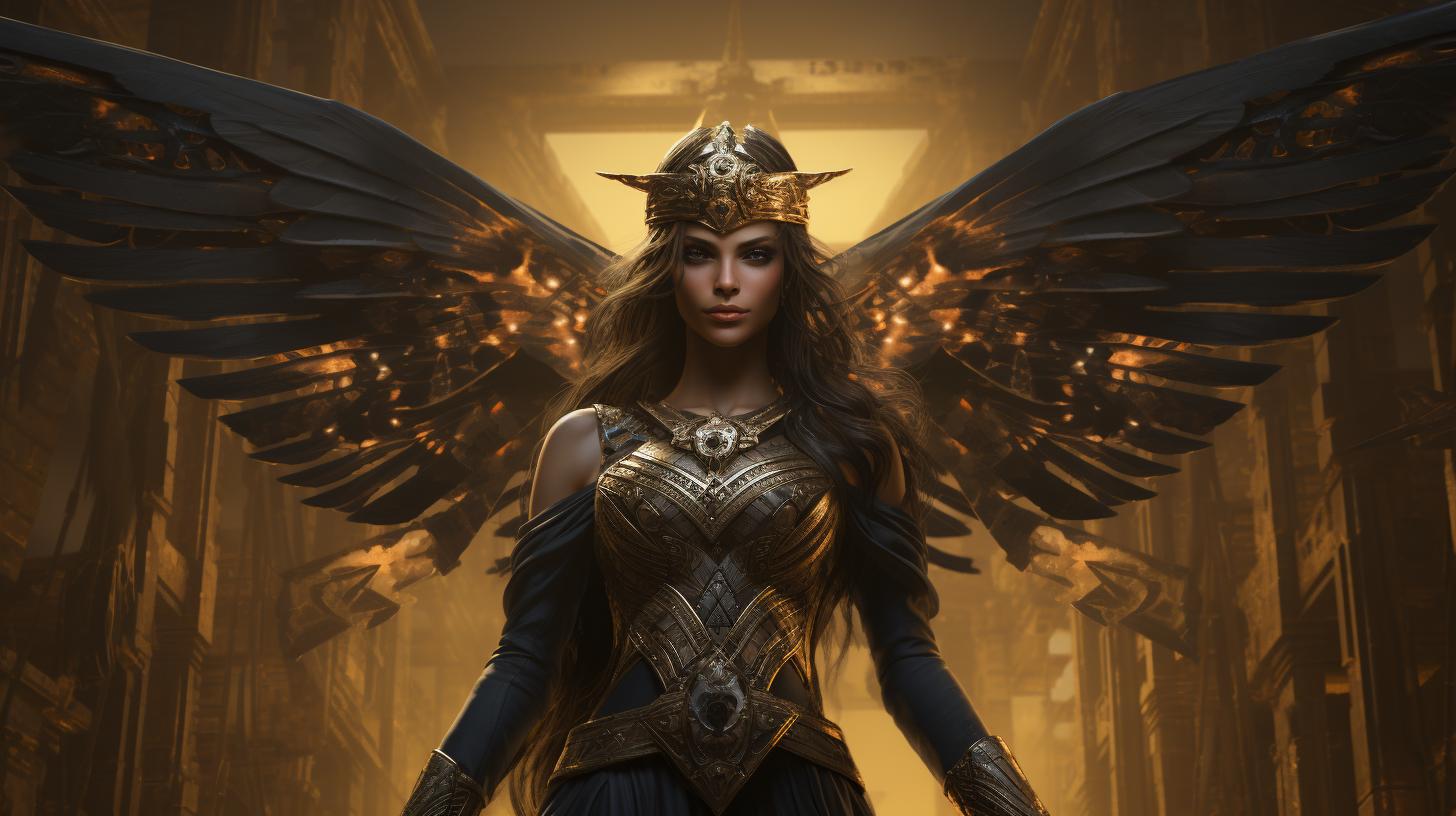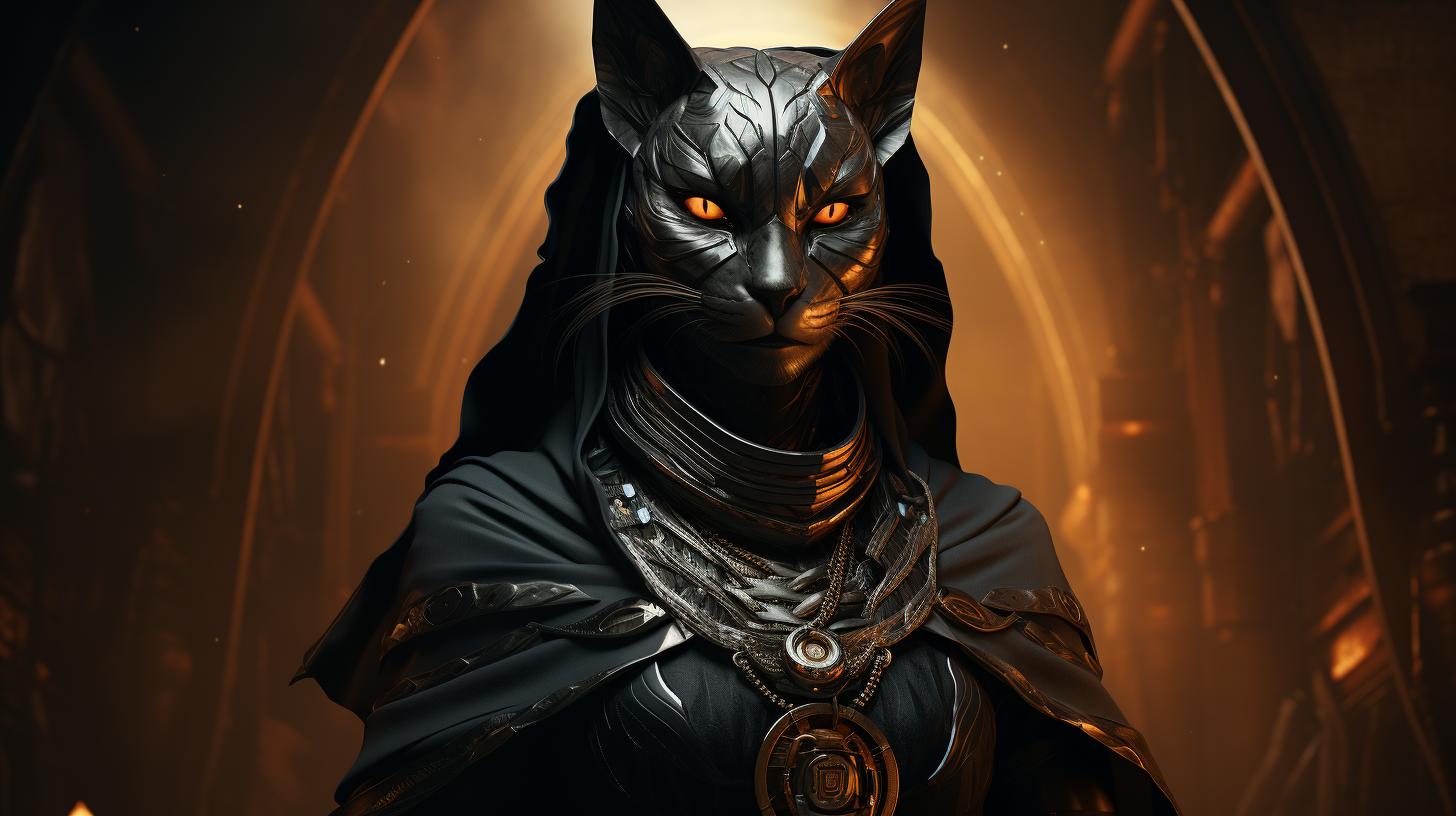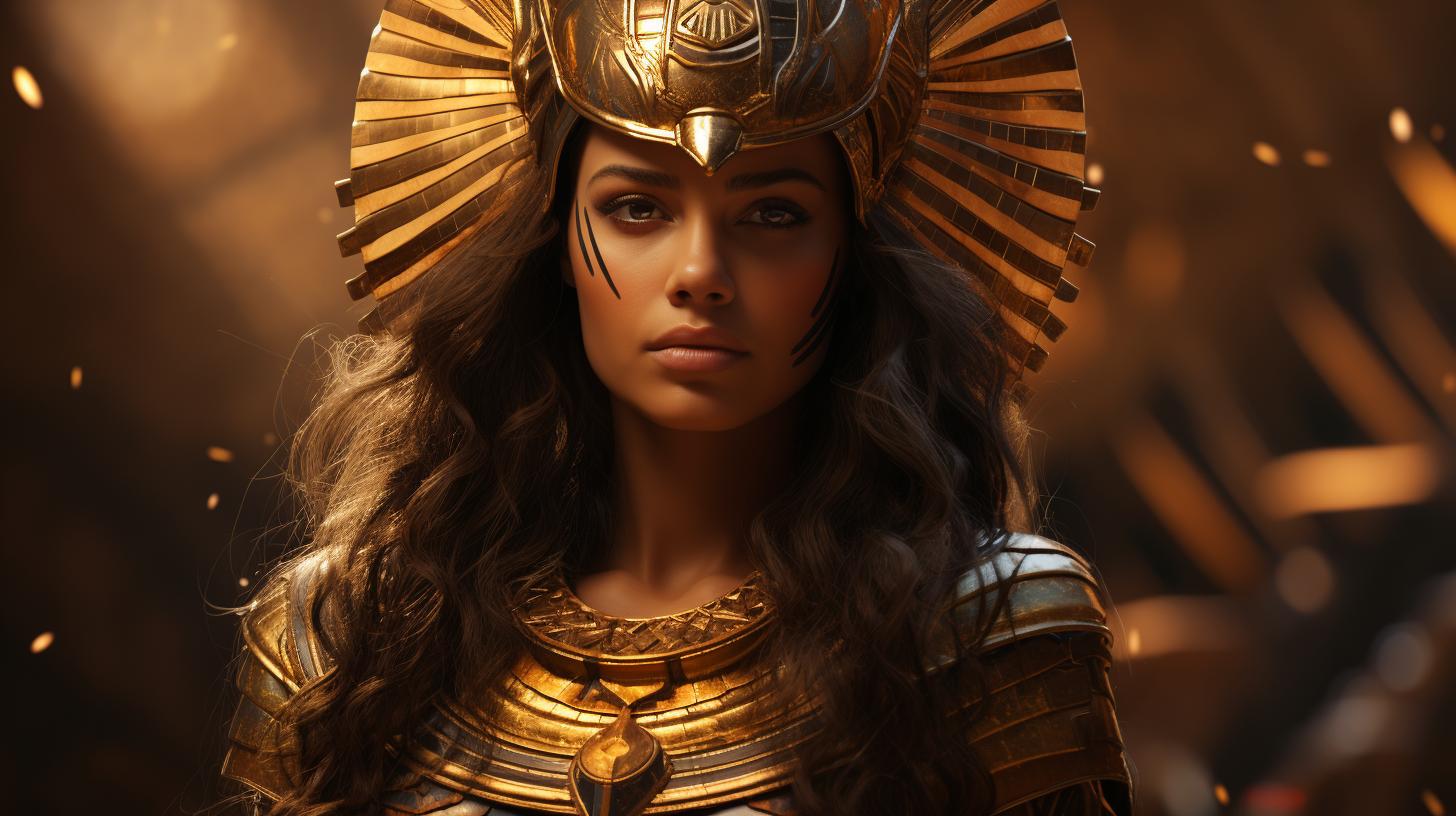Egyptian Goddess Seshat: Unveiling the Ancient Secrets of Knowledge and Writing
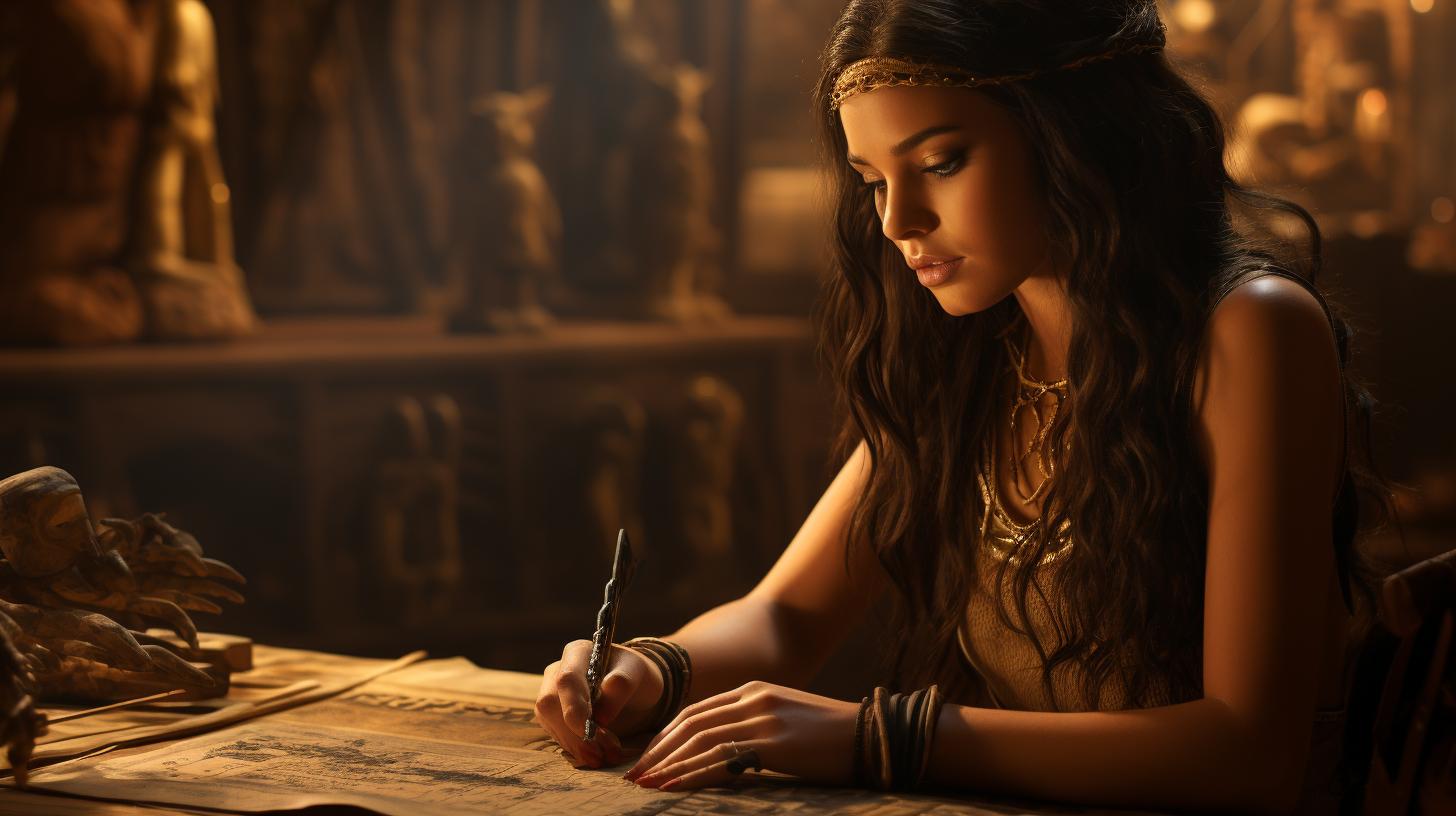
Egyptian goddess Seshat played a significant role in ancient Egyptian religion, specifically as the goddess of writing and knowledge. Believed to be the guardian of records, she was associated with various disciplines such as arithmetic, architecture, astronomy, and topography.
Seshat, often depicted as a woman wearing a leopard-skin dress and a distinctive headdress, held a palm frond with notches symbolizing time measurement. She was considered Thoth’s consort and mother of their son, Hornub.
Seshat’s importance extended to record-keeping, library management, and architectural planning. Although no dedicated temples to her have been found, marvelous depictions and inscriptions attest to her significance in Egyptian society, particularly alongside Ptah and Thoth.
This introduction serves as a brief overview of the prominent Egyptian goddess Seshat, highlighting her role in religious practices, symbolism, societal contributions, and connections with other deities.
The subsequent sections delve deeper into her beliefs, depictions, and involvement in ancient Egyptian life and mythology, shedding light on her revered status in the civilization’s cultural and religious fabric.
The Role of Seshat in Ancient Egyptian Religion
Seshat held a significant position within the ancient Egyptian belief system, playing a crucial role in various aspects of their religious practices and mythology.
Let’s explore the different facets that comprised her role in ancient Egyptian religion.
Beliefs and Worship of Seshat
Believed to be the goddess of writing and knowledge, Seshat was highly revered and worshipped by the ancient Egyptians. She was considered the divine patroness of record-keeping, counting, and measuring, all essential skills for maintaining order and stability in society.
The Egyptians turned to Seshat for guidance in scribing important documents, such as temple blueprints, royal decrees, and historical records.
As a goddess associated with wisdom, Seshat was also venerated for her ability to confer immortality through writing.
The ancient Egyptians believed that by recording their names and deeds, they could secure a lasting legacy in the afterlife. Rituals and ceremonies, including offerings and prayers, were conducted to honor and seek the blessings of Seshat.
Seshat and the Egyptian Pantheon
Within the rich tapestry of Egyptian mythology, Seshat held a unique place among the gods and goddesses. She was closely associated with Thoth, the god of wisdom and writing. In some accounts, Seshat was believed to be Thoth’s sister, while in others, they were seen as a married couple or even mother and son.
This close relationship emphasized their divine partnership in the realms of knowledge and communication.
Furthermore, Seshat’s significance extended beyond her connection with Thoth. She interacted with other deities within the Egyptian pantheon, collaborating with Ptah, the god of craftsmen and architecture, and Djehutykhnum, the god of measurement.
These alliances highlight her multifaceted role in ancient Egyptian religion.
Seshat as the Goddess of Writing and Knowledge
Epitomizing the power of the written word, Seshat personified writing and knowledge in ancient Egypt. She was considered the keeper of divine and earthly records, entrusted with safeguarding the wisdom and heritage of the gods.
The ancient Egyptians recognized her as the “Mistress of the House of Books” and the “Mistress of the House of Architects.” These titles emphasized her role as the guardian of mystical knowledge and her involvement in overseeing the construction of sacred structures.
As the goddess of writing, Seshat played a vital role in disseminating information and preserving historical accounts. Ancient Egyptian society deeply valued literacy and the ability to record events accurately. Seshat’s association with writing elevated her status as a revered deity who facilitated the transfer of wisdom and served as a guiding light for scholars, scribes, and those seeking intellectual enlightenment.
Key Points:
- Seshat was highly worshipped and revered for her association with writing and knowledge.
- She was considered the goddess of record-keeping, counting, and measuring.
- Rituals and ceremonies were conducted to seek her guidance and blessings.
- Seshat had a close relationship with Thoth, Ptah, and Djehutykhnum.
- Her role as the guardian of divine and earthly records emphasized her significance.
- Seshat played a crucial role in disseminating information and preserving historical accounts.
Depiction and Symbolism of Seshat
Seshat’s Physical Representation
Seshat, the Egyptian goddess of writing and knowledge, was commonly depicted as a woman adorned in a distinctive attire. She was often depicted wearing a leopard-skin dress, symbolizing her connection to the animal kingdom and wild nature.
Her headdress was a significant aspect of her representation, featuring a seven-pointed star sitting upon a pair of inverted horns. This unique headpiece symbolized her role as a celestial deity and her connection to cosmic forces.
The star is thought to represent the guidance and wisdom she bestowed upon humanity.
Symbolic Objects Associated with Seshat
In addition to her physical appearance, Seshat was often portrayed carrying a palm frond with notches. This palm frond, also known as a “palm rib,” served not only as a writing instrument but also as a symbolic representation of time measurement.
The notches on the frond symbolized the divisions of time, emphasizing Seshat’s association with the recording and tracking of temporal events. The palm frond also alluded to her role as the goddess of architecture and symbolized her involvement in the planning and construction of sacred structures.
Seshat’s Role in Ancient Egyptian Society
Seshat played a significant role in various aspects of ancient Egyptian society, showcasing her importance in record-keeping, administration, writing, and architecture.
The Importance of Seshat in Record-Keeping and Administration
Seshat held a crucial position as the overseer of record-keeping and administration. She ensured the accurate documentation of important events, such as the reigns of pharaohs, religious ceremonies, and royal decrees.
Seshat’s meticulous attention to detail was vital in preserving historical knowledge and maintaining the stability of Egyptian society.
Seshat as the Patron of Writing and Librarian of the Gods
As the goddess of writing, Seshat was revered as the patron of scholars and scribes. She oversaw the development and dissemination of written knowledge, elevating the significance of writing as a divine art.
Seshat’s role as the Librarian of the Gods involved safeguarding the sacred texts and imparting wisdom to those who sought knowledge.
Roles of Seshat as the Librarian of the Gods:
- Preserving and organizing the divine texts
- Guiding scribes in the transcription of ancient manuscripts
- Supervising the creation and maintenance of extensive libraries
- Granting access to the gods’ intellectual treasures
Seshat’s Involvement in Architecture and Temple Design
Seshat’s influence extended to the architectural realm, where she played a vital role in temple design and construction.
Her expertise in surveying, astronomy, and mathematics made her an integral collaborator in the planning and layout of sacred structures. Seshat meticulously measured and marked the specifications for temple foundations, ensuring their alignment with celestial bodies and divine harmony.
Furthermore, Seshat’s involvement in temple design encompassed more than just physical aspects. She infused symbolic and mystical elements into the architectural blueprint, aligning them with the religious beliefs and cosmic order of ancient Egypt.
Significance of Seshat’s Architectural Contributions:
- Enabling the harmonious coexistence of divine and human realms within the temples
- Ensuring the alignment of temple structures with celestial events and divine energies
- Infusing symbolic representations into temple design to convey religious beliefs
Overall, Seshat’s multifaceted roles in record-keeping, administration, writing, and architecture solidified her position as a central figure in ancient Egyptian society.
Her contributions to the preservation of knowledge, intellectual pursuits, and sacred constructions were instrumental in maintaining the cultural, religious, and societal fabric of ancient Egypt.
Myths and Legends Related to Seshat
The intriguing myths and legends surrounding the Egyptian goddess Seshat shed light on her divine connections and significant role in ancient Egyptian culture.
Explore these captivating narratives that intertwine Seshat with other prominent deities of the pantheon.
Seshat’s Connection to Thoth and Hornub
One of the most renowned myths involves Seshat’s close relationship with Thoth, the god of wisdom and writing. Seshat is believed to be Thoth’s consort, and together they birthed a son named Hornub.
This divine family unit represents the harmonious union of knowledge, creativity, and record-keeping within the Egyptian mythos.
Seshat’s Involvement in Creation and the Afterlife
According to certain legends, Seshat played a crucial role in the creation of the world and the establishment of cosmic order. She contributed her expertise in architectural planning and precise measurements, ensuring the proper construction and alignment of sacred structures.
In the realm of the afterlife, Seshat aided the deceased by recording their deeds and guiding them towards a favorable judgment in the Hall of Ma’at.
Seshat in the Stories of Osiris and Isis
Seshat also features in the captivating tales surrounding the deities Osiris and Isis. As the goddess of writing and knowledge, she provided invaluable assistance to the goddess Isis during her quest to resurrect her husband Osiris. Seshat’s expertise in written spells and incantations had a profound impact on the success of their endeavors, further cementing her significance in the Egyptian pantheon.
Explore these enthralling myths and legends, which celebrate the multifaceted nature of Seshat’s divine influence and her enduring presence within Egyptian mythology.
Temples and Worship of Seshat
The temples dedicated to the Egyptian goddess Seshat played a crucial role in ancient Egyptian religious practices. Seshat was honored and revered in various temples throughout Egypt as worshippers sought her guidance and protection.
Seshat and Her Place in Egyptian Temples
Seshat held a significant position in the hierarchy of Egyptian temples. While no temples were specifically dedicated to her, she was often honored alongside other prominent deities. Seshat’s presence can be seen in the sacred precincts of temples dedicated to gods such as Ptah and Thoth, who were closely associated with her.
Evidence of Devotion to Seshat in Ancient Texts
The devotion to Seshat can be found in various ancient texts and inscriptions. These texts mention rituals, prayers, and offerings made to honor the goddess. Seshat’s significance in record-keeping and administration is highlighted in temple documents and administrative records, emphasizing the importance placed on her role within the temple hierarchy.
Rituals and Offerings to Honor Seshat
Worshippers of Seshat carried out elaborate rituals and ceremonies to pay homage to the goddess. These rituals involved offerings of food, incense, and beverages, symbolizing the devotees’ gratitude and reverence for Seshat’s guidance and wisdom.
The performance of sacred rites, accompanied by prayers and invocations, sought to establish a spiritual connection with the goddess and seek her blessings.
Devotees often visited the temples to seek Seshat’s assistance in matters related to knowledge, writing, and architecture.
They believed that by honoring and worshiping her, they would gain her favor and receive her divine guidance in their pursuits.
In conclusion, the temples dedicated to Seshat served as important centers of worship and reverence.
They provided a space for devotees to connect with the goddess, seek her favor, and express their gratitude. The evidence of devotion to Seshat found in ancient texts reinforces her significant role in Egyptian society and the value placed on her expertise in writing, knowledge, and architectural planning.
Ancient Egyptian Gods and Goddesses
Learn about other deities in the Egyptian pantheon and their respective domains. Understanding the relationships between Seshat and other gods can provide insights into her religious significance.
Egyptian Hieroglyphics and Writing System
Discover the intricacies of the ancient Egyptian writing system, including the hieroglyphics.
Explore how Seshat’s role as the goddess of writing influenced the development of this complex script.
The Role of Women in Ancient Egyptian Religion
Delve into the position of women in ancient Egyptian society and their involvement in religious practices. Gain a broader understanding of the significance of goddesses like Seshat in shaping societal roles.
Thoth: The Divine Scribe and Wisdom Deity
Explore the relationship between Seshat and Thoth, the god of wisdom and writing. Learn how their roles intertwine and how they complement each other within the Egyptian pantheon.
Ancient Egyptian Temples and Architecture
Uncover the architectural marvels of ancient Egyptian temples and the symbolic elements incorporated in their design.
Understand how Seshat’s involvement in temple planning and architecture influenced the religious landscape.












